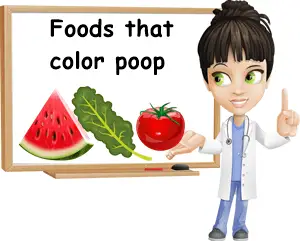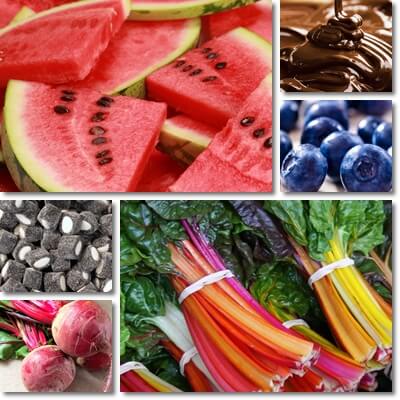Changes in stool color are often a cause for concern and can have us instantly thinking the worst about our health. Naturally, our first instinct is to panic, but it turns out some foods can dye stools different colors. We all know a brown stool means a healthy, normal stool, but what happens if it suddenly just changes color? The changes can be more subtle such as lighter or darker brown, or blatantly obvious such as green, yellow, orange, red or black. Stools can also come out having two colors, such as yellow next to dark brown. And it could all be because of what we ate the day or days before, be it food, medication or even some natural supplements.
When our stool color strays from what we know is normal for us, we may tend to jump to conclusions, such as thinking we have a disease. Indeed, abnormal stool colors can be an indication of disease, but only if they persist and cannot be traced back to something we ate. Additional symptoms may sometimes indicate a pathology, warranting medical investigation. But if you happened to eat any of the following foods in the day or days leading up to the change in stool color, it might just be that it was the foods that colored your stools.

Red beet (red beetroot)
Red beets contain natural pigments called betalains (example: betanin, neobetanin, isobetanin, probetanin). Eating fresh, cooked or pickled red beets or drinking red beetroot juice causes stools to change color. More exactly, your poop can completely turn red, violet-red or purple. If you only have very little of the vegetable or its juice, it can still come out brown, but with a reddish-purple tinge or with red streaks that mimic blood in the stool. Because betanin pigments in red beets are a common food dye, you can find them in cold meats such as sausages, bacon, salami etc., tomato juice and tomato paste, canned tomato soup, red-purple fruit juices, red-purple candy such as hard-candy, icing, ice cream, fillings for baked sweets or pastry, red gelatin and so on.
Betanin pigments are also found in cactus and amaranth flowers, but these are inedible, so the main source of betalain pigments in the human diet are red beetroots. Eating red beets or foods colored with red beetroot extract or drinking red beet juice also causes urine to change color and turn pink or red. The condition is known as beeturia and is harmless, urine color returning to normal once all the beetroot pigment is eliminated from the body. Also see what urine colors mean.
Swiss chard
Swiss chard is also commonly called leaf beet or beet spinach. Why? Because it’s yellow and pink-red stems contain the betanin pigments also found in red beets. The red stems have red betanin pigments called betacyanins (example: betanin), while the yellow stems have yellow betanin pigments called betaxanthins. Which means that if you eat enough chard with red stems, your stools can change color to red or red-purple. Juicing the stems can have the same effect, but again, intensity of color is determined by intake.

Red tomatoes
Varieties of red tomatoes owe their intense color to a natural pigment called lycopene. Lycopene is a red carotenoid antioxidant, commonly used as a natural food colorant. Eating too many red tomatoes or too much tomato sauce, paste, ketchup or drinking too much tomato juice can cause stools to turn red. Lycopene supplements can have the same side effect. Depending on how much of the fruit you eat at once or how often you eat it, the red color imparted to the stools may be more or less obvious, but should be temporary nonetheless. Cooking tomatoes and eating them with some fat has the added benefit of making lycopene more bioavailable and more likely to produce health benefits such as counteracting free radical damage, reducing the risk for blood clots and lowering high blood pressure. Eating fresh tomatoes with skin by themselves (but no fat) doesn’t ensure the same bioavailability of the antioxidant and may cause pieces of undigested tomato peel appearing in stools to be mistaken for blood.
Watermelon
The beautiful pink-red color of watermelon is a result of the antioxidant lycopene. Eating too much watermelon at once or eating it too often can cause the lycopene to accumulate and color stools red. If you notice your stools changing color and going from a normal light or darker brown to red-tinted, and you know you’ve had watermelon recently, consider the fruit a potential culprit. Expect the effects to pass in a couple of days after you discontinue consumption. Other sources of lycopene include pink grapefruit, pink guava, goji berries, sea buckthorn, rosehip and gac fruit. Also see the benefits of gac fruit.
Red, orange and yellow peppers
Peppers are both culinary vegetables and condiments, used to add flavor to various foods. Red, orange and even red varieties of sweet and spicy peppers are rich in pigments and, as a result, used to naturally dye some foods to make them stand out. Red bell peppers contain Capsorubin and Capsanthin, two carotenoid pigments commonly used as food dyes (E160c – or Paprika oleoresin, an oil-soluble extract). The two carotenoids are commonly added to spice mixes, orange-red fruit juices, some processed meats such as cold cuts (salami, bacon, cured ham, sausages), some cheeses and poultry feed to naturally alter the color of egg yolks. Getting too much of these pepper pigments from you diet can temporarily change your stool color to an orangey-red. A lot of foods are also either flavored or dyed with red pepper powder, aka paprika, which can also contribute to minor changes in stool color. Also see the benefits of paprika.
Other pigments in peppers include alpha and beta-carotene, beta-cryptoxanthin, lutein and zeaxanthin. Don’t be surprised if your poop, which is normally brown, changes color and acquires an orange or red hue after you’ve eaten roasted red bell peppers or a vegetable stew with red peppers. Alternatively, eating the whole vegetable can cause brown stools with red spots, where the red spots are actually undigested or partially digested pieces of pepper.
Escolar and oilfish
Lepidocybium flavobrunneum, commonly known as the escolar fish, and Ruvettus pretiosus, or the oilfish, are two species of snake mackerel. While, edible, the escolar and the oilfish contain wax esters that are poorly absorbed in humans. Eating too much of the fish at once or too often causes an oily orange diarrhea called keriorrhea. Other symptoms may include nausea, vomiting and abdominal cramps. The Atlantic butterfish or the American butterfish (Peprilus triacanthus) is reported to cause the same side effects: diarrhea and an orange stool color.
Leafy greens: spinach, kale
Spinach is known to color your stool green. Depending on how much spinach you eat at once, how often you eat it, and what the rest of your diet looks like, the change in stool color may be more or less pregnant, ranging from a lighter green to a darker green. The change in bowel movements color is attributed to both carotenoid antioxidants such as neoxanthin and chlorophyll. Some say the high content of iron in spinach may be partially responsible for darker green stools. Kale and other leafy greens can have the same effect on bowel movement appearance. Drinking juices made from leafy greens on a regular basis can too.
Green algae and algae supplements
Chlorella is a green algae known to be rich in chlorophyll a and chlorophyll b pigments. Spirulina is a blue-green algae rich in chlorophyll, but also the carotenoid zeaxanthin. Both are marketed as dietary supplements and studies have found they are important sources of protein and essential vitamins and minerals. However, supplementation is known to cause green stools, changes that can be attributed primarily to chlorophyll.
Kelp and edible seaweed
Edible seaweed is an important source of both essential nutrients (especially iodine, essential for thyroid health) and pigments. Regular consumption of kelp species can impart a darker green color to stools. Various species of edible seaweed such as kelp are marketed as dietary supplements and their uses include: correcting iodine deficiencies for improved fertility, faster metabolism and weight loss, correcting potassium deficiencies for better blood pressure numbers, providing an alternative source of essential Omega-3 fatty acids for brain, nervous system, cardiovascular and skin health, boosting the immune system etc.
Cocoa and chocolate
A lot of people eat cocoa and chocolate regularly and have normal-looking stools in terms of color. What is a normal stool color? Typically a medium to slightly darker brown, so brown. But for some people, eating cocoa or chocolate, especially dark chocolate, can cause changes in stool color. Not all cocoa and chocolate products have this effect though. For example, the extremely popular Nutella and Oreo, both of which contain cocoa, can definitely add more color to your bowel movements. I don’t eat any of them on a daily basis, but I’ve noticed that when I do eat Oreos or a few tablespoons of Nutella, or have them several days in a row, I notice darker brown stools over the course of the next day or days. It’s a darker brown than normal, but dark enough to have made me wonder if it’s actually black.
Black licorice
Normal stool color is brown and anything that strays from brown can really trigger anxiety in some people. The color known to stir up the most worry is black because black bowel movements are known to be caused by old blood originating from a bleeding site somewhere higher along the gastrointestinal tract. But did you know that eating black licorice can color your stools a dark green to almost black color? The change in color is attributed on the one hand to the extract of licorice root used for achieving the black color of the confectionery (Glycyrrhiza glabra, aka licorice) and, on the other hand, to the molasses, aka refined sugar syrup used in the confectionery, which is black.
Blueberries
Can blueberries change stool color and cause dark stools? Yes, actually. Eating large amounts of fresh blueberries or juices or sweets containing blueberries or blueberry extract can cause stool color to change from brown to dark green or dark purple which can easily be mistaken for black. Blueberries are rich in anthocyanin antioxidants which are sources of red, blue, purple and black colors in fruits and other foods. So blueberries don’t actually turn your poop black, but rather a darker blue-green-purple color that can be mistaken for black.
Conclusion
If one day you notice your poop isn’t brown like it normally is, don’t jump to conclusions right away. Instead, take a moment and think about what your ate the day or days before. If you had red beets, Swiss chard, spinach, kale, Oreos, Nutella, black licorice, red-purple fruit juices or candy or other foods that color stools, then consider waiting a couple of days to see if your stool returns to its normal brown color. Depending on how much of these pigmented foods you had, it may take a couple of days to flush all the pigment out. If your stool doesn’t return to what you consider to be a normal color for you in a couple of days or you experience symptoms such as severe abdominal cramps, nausea, vomiting, fatigue or fainting, then see your healthcare provider for some tests.
